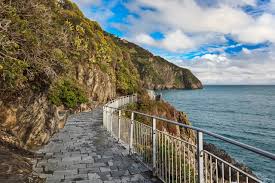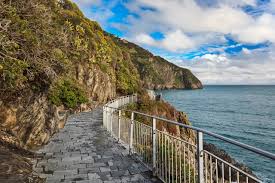Italy: “Path of Love” reopens after 12 years

Rome: The Cinque Terre’s most romantic hiking trail – aptly dubbed the Via dell’Amore (Path of Love) – is reopening in Italy on 27 July, 12 years after the September 2012 landslide that injured four Australian tourists and highlighted the area’s dire need for renovations and increased safety measures. The 800m footpath, carved on steep cliffs with breathtaking views of the Ligurian sea, has a 104-year history and a future that crucially depends on the preservation of Italy’s coastal landscapes.

Prior to its 2012 shuttering, the stunning route was one of the most popular tracts of the 130km network of trails crisscrossing the “five lands” that give Cinque Terre its name; linking the romantic multi-coloured medieval borghi (villages) of Riomaggiore and Manarola.
Ironically, no one ever planned to build the Path of Love. Today, Riomaggiore and Manarola – “vertical” villages perched on majestic rocks with houses stacked upon each other like pastel scoops of gelato – attract millions of international tourists, all chasing a technicolour Italian fantasy. But originally, they were simple settlements of seafaring farmers (not fishermen, as often mistakenly believed); connected only by an ancient trail over a precipitous peak, so arduous to cross that communication was scarce and the two tiny villages spoke different dialects.
But during the construction of the railway between the cities of Genova and La Spezia at the end of the 19th Century, portions of a stone path were carved into the cliffs for workers and donkeys carrying materials and explosives to dig train tunnels.
The “five lands” of Cinque Terre – Monterosso al Mare, Vernazzo, Corniglia, Manarola and Riomaggiore – are all contained within the Unesco-listed Cinque Terre National Park, interlaced by 48 trails of varying intensity. The most convenient way to explore is with the Cinque Terre Express trains, which run every 20 minutes and will take you through all five towns. Or put on your hiking boots and pick a path, armed with the Cinque Terre Card that allows visitors entry to the park and access to park services including guided visits and free use of the bathrooms. Take pitstops to sample the area’s delicacies like heaping plates of pasta with pesto, Ligurian focaccia and sardines. You can also visit the villages by ferry. Four of the park’s trails are now accessible to people with disabilities.

Locals saw an opportunity to connect the two fragmented paths. Fabrizia Pecunia, the current mayor of Riomaggiore, explains: “They saw this piece of [railway service] road on the Riomaggiore side, and this other stretch on the Manarola side, and wondered: ‘Why don’t we create a link?'” Construction of the new footpath started in 1920 and ended about 11 years later. “My grandfather Brizio Bonanini was one of the people who built it,” says Pecunia. “And I am so proud of it.”
With languid sunset views of the sea and a dramatic rocky landscape over the waves crashing about 30m below, this flat, easy to traverse trail soon became an ideal and practical solution for a date night, not far from the villages’ medieval centres. Then, an anonymous scribbler with a knack for branding wrote Via dell’Amore on the rock wall, thus lending the path its romantic name. Fifty years later, in the 1970s, the local officials caught on, and installed benches dedicated to mythological figures of passion, from Cupid to Eros.
The only hitch: the Path of Love was built on a steep and crumbling mountainside, in a region whose terrain yields frequent landslides. “It is an obviously dangerous area – a very beautiful area because it is on the sea – but obviously dangerous,” explains Francesco Faccini, a geologist with the University of Genova. “It is no coincidence that the original ancient path was built going over the mountain [and not on the side]. Inevitably, cutting the base of a slope leads to collapses.”
The entire Cinque Terre is a manmade gamble with nature. “These were the lands of ‘heroic viticulture’,” says geologist Domenico Calcaterra from the University of Naples, “Lands of a dramatic and dangerous agriculture. Men and women would work on very narrow paths along impervious slopes and accidents were not uncommon.” Over the centuries, inhabitants built dry stone walls to hold up the terraces, where they cultivated olive trees and vineyards. “It’s a unique landscape,” adds Donatella Bianchi, the president of Cinque Terre National Park. “It is vertical, with 130km of paths created by men who transformed the mountains to farm them and survive.”
With the advent of tourism in the 1950s, agriculture in the area was abandoned and the maintenance of the stone walls was neglected, while climate change progressively saw the same amount of yearly rain concentrated in fewer, heavier storms.
“Today, the communities who created this wonderful landscape, including those very important paths, will be able to appreciate its beauty again” – Donatella Bianchi
“As it unfortunately often happens in our country, a new [environmental] awareness was developed only in the aftermath of a tragedy,” says Calcaterra, referring to the two years of landslides and dramatic floods between 2011 and 2012. The new park leadership decided then to focus more deeply on the environment and created the Centre for the study of geological risks, where Calcaterra works. They also began supporting agriculture with incentives for farmers, providing rocks to fix the dry walls, and barbatelle (grapevine cuttings) for the production of the prestigious local wine; the sweet white passito Sciacchetrà.
“Today, the communities who created this wonderful landscape, including those very important paths, will be able to appreciate its beauty again,” says Bianchi.
But why did it take 12 years to reopen an 800m path? Tourism minister Daniela Santanchè, who will inaugurate the trail later this month, chuckles at this question: “Have you seen Liguria? It’s a thin region rising steeply from the sea. We had to harness the entire mountain, and make sure everything was completely safe.”
“It cost a total of €22m,” adds Mayor Pecunia, describing how the various local and national entities involved had to collect funds, agree on a plan, go through all the red tape and finally build a system of harnesses, nets and anchors to both prevent rock falls and protect the path, without ruining its natural beauty. “And now, if you go, you’ll fall in love with it,” Santanchè muses romantically. “It’s not by chance that it’s called the Path of Love.”
Visitors will be able to walk the path again starting on 27 July, booking their ticket online, or at the park’s ticket booths. A maximum of 400 people will allowed on the path per hour – a new policy aimed at limiting overcrowding – and the park, one of the smallest but most densely populated in Italy with 4,000 inhabitants over 3,800 hectares, hopes to monitor the number of visitors and inform tourists how crowded the park is before they arrive.
Interestingly, although full wedding ceremonies on the Path of Love will have to wait for next year’s opening of the path’s small amphitheatre that doubles as a botanical garden, Mayor Pecunia guarantees that very intimate weddings with only a few guests and no refreshments or a reception are permitted starting this summer. After all, no one can really control romance and who exchanges vows on the Path of Love.





